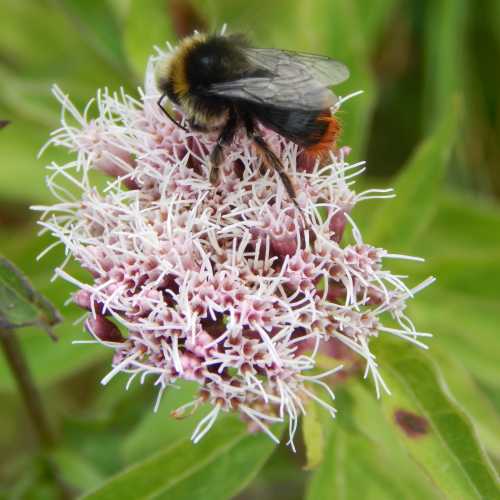The Status Of North America's Cuckoo Bumble Bees
North America and Canada have 6 species of cuckoo bumble bee.
This page is about the status of cuckoo bumble bees found in North America, according to the IUCN.
IUCN Red List Categories And Criteria
The IUCN Red List Categories and Criteria are intended to be an easily and widely understood system for classifying species at high risk of global extinction.
Species that have been evaluated AND where there is sufficient data available, may fall into one of 7 IUCN Red List categories (adapted and abbreviated information from the IUCN website):
EXTINCT
A species is presumed Extinct when exhaustive
surveys in known and/or expected habitat, at appropriate times (diurnal,
seasonal, annual), throughout its historic range have failed to record
an individual.
EXTINCT IN THE WILD
A species is Extinct in the Wild when it is known only to survive in
cultivation, in captivity or as a naturalized population (or
populations) well outside the past range.
CRITICALLY ENDANGERED
A species is Critically Endangered when the best available evidence
indicates that it meets any of the criteria for the IUCN's Critically
Endangered categories, and it is therefore considered to be facing
an extremely high risk of extinction in the wild.
ENDANGERED
A species is Endangered when the best available evidence indicates that it
meets any of the criteria for the IUCN's Endangered category, and it
is therefore considered to be facing a very high risk of extinction in
the wild.
VULNERABLE
A species is Vulnerable when the best available evidence indicates that it
meets any of the IUCn's criteria for Vulnerable, and it
is therefore considered to be facing a high risk of extinction in the
wild.
NEAR THREATENED
A species is Near Threatened when it has been evaluated against the
criteria but does not qualify for Critically Endangered, Endangered or
Vulnerable now, but is close to qualifying for, or is feared likely to qualify
for a threatened category in the near future.
LEAST CONCERN
A species is Least Concern when it has been evaluated against the criteria
and does not qualify for Critically Endangered, Endangered, Vulnerable
or Near Threatened. Widespread and abundant taxa are included in this
category.
IUCN Status Of North America's Cuckoo Bumble Bees
There are three bumble bees classified as 'Critically Endangered' by the IUCN, tow of 'Least Concern', and a further species that is of 'Least Concern' in North America and Europe, but classified as 'Data Deficient' overall, due to a lack of information from Asia.
Key points from the IUCN website (as of May 2018):
Least Concern
Bombus insularis - (Smith, 1861) - Indiscriminate Cuckoo Bumble Bee
- Declines in abundance or range of this widely distributed North American species have been relatively low, range-wide (Hatfield et al. 2014).
- This species is recommended for the Least Concern Red List category.
- However, given the decline
of this species in some parts of its range, and its dependence upon strong
populations of its' host bees for survival (many of which are in decline),
frequent re-evaluation for any population changes and threats is recommended.
Bombus citrinus (Smith, 1854) - Lemon Cuckoo Bumble Bee
- According to IUCN analyses, this eastern North American bumblebee has not declined in distribution or relative abundance in the past decade (Hatfield et al. 2014).
- Note that the abundance and distribution of this
species are likely to depend on abundance and distribution of host species,
which remain common.
- The IUCN recommend this species for the Least Concern Red List category at this time.
Critically Endangered
Bombus suckleyi - (Greene, 1860) - Suckley Cuckoo Bumble Bee
- According analysis, this western North American species has experienced rapid declines in relative abundance in recent years (Hatfield et al. 2014).
- The decade by decade relative abundance regression shows a gradual decline since the 1940s, and the relative abundance regression over just the past 50 years is highly significant.
- This species' decline
mirrors that of B. occidentalis, a primary host. Both the past decline in
relative abundance (90.11% over the past 10 years) and predicted future
decline in relative abundance (based on 50-year regression) justify a
Critically Endangered listing.
Bombus bohemicus (Seidl, 1838) - Ashton's Cuckoo Bumble bee
- In North America, this species is declining rapidly, currently found in only approximately seven known sites.
- Its population reduction in North America is suspected to have been more than 80% in the past decade based on a 97.18% decline in relative abundance between recent (2002-2012) and historic (1805-2001) time periods and a 96.28% decline in extent of occurrence (EOO) has been observed between recent and historic time periods.
- This species uses both Bombus terricola and B. affinis as hosts, and there has been a decline in the availability of these hosts.
- This species meets the criteria for the Critically Endangered Red
List Category under criterion in its North American range.
Bombus variabilis (Cresson, 1872) - Variable Cuckoo Bumblebee
- Considered to be one of the rarest of all North American bumble bee species, having been collected only a few times in the past twenty years, and not at all in the last decade (Williams et al. 2014 and supporting database).
- The decade by decade relative abundance trend has been consistently downward since the 1920s, reaching zero in the recent decade
- The IUCN recommend this species for the Critically Endangered category at this time.
Data Deficient
Bombus flavidus (Eversmann, 1852) - Fernald Cuckoo Bumble Bee
- Status: Least Concern in Europe and North America.
- However, lack of information from the Asian part of its range leads to our recommendation of a Data Deficient assessment for this species at this time.
If you found this page helpful or interesting, I'd really be grateful if you would share it with others - if not this page, perhaps another, such as Gardening For Bees.
Thank you so much :) .
